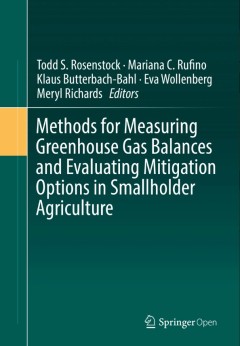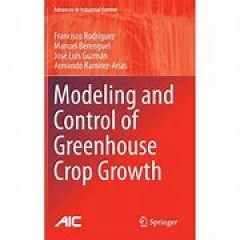Filter by

The Tomato Genome
This book describes the strategy used for sequencing, assembling and annotating the tomato genome and presents the main characteristics of this sequence with a special focus on repeated sequences and the ancestral polyploidy events. It also includes the chloroplast and mitochondrial genomes. Tomato (Solanum lycopersicum) is a major crop plant as well as a model for fruit development, and the av…
- Edition
- -
- ISBN/ISSN
- 978-3-662-53389-5
- Collation
- -
- Series Title
- -
- Call Number
- -

The Sustainability of Agro-Food and Natural Resource Systems in the Mediterra…
This book is focused on the challenges to implement sustainability in diverse contexts such as agribusiness, natural resource systems and new technologies. The experiences made by the researchers of the School of Agricultural, Forestry, Food and Environmental Science (SAFE) of the University of Basilicata offer a wide and multidisciplinary approach to the identification and testing of differ…
- Edition
- -
- ISBN/ISSN
- 978-3-319-16357-4
- Collation
- -
- Series Title
- -
- Call Number
- -

The Sorghum Genome
This book provides insights into the current state of sorghum genomics. It particularly focuses on the tools and strategies employed in genome sequencing and analysis, public and private genomic resources and how all this information is leading to direct outcomes for plant breeders. The advent of affordable whole genome sequencing in combination with existing cereal functional genomics data has…
- Edition
- -
- ISBN/ISSN
- 978-3-319-47789-3
- Collation
- -
- Series Title
- -
- Call Number
- -

The Soils of Taiwan
Physical Geography
- Edition
- -
- ISBN/ISSN
- 978-94-017-9726-9
- Collation
- -
- Series Title
- -
- Call Number
- -

The Soils of Iceland
In this new volume in the World Soil series, the various types of Icelandic soils, their different characteristics, their formation, degradation and erosion are reviewed. At the same time, the book also deals with the agriculture and land use in general to give a complete view of Icelandic soils. The first part details the natural parameters such as the climate and the geography of Iceland. It …
- Edition
- -
- ISBN/ISSN
- 978-94-017-9621-7
- Collation
- -
- Series Title
- -
- Call Number
- -

Elucidation of Abiotic Stress Signaling in Plants Functional Genomics Perspe…
Abiotic stresses such as high temperature, low-temperature, drought, and salinity limit crop productivity worldwide. Understanding plant responses to these stresses is essential for rational engineering of crop plants. In Arabidopsis, the signal transduction pathways for abiotic stresses, light, several phytohormones and pathogenesis have been elucidated. A significant portion of plant genomes …
- Edition
- 1
- ISBN/ISSN
- 978-1-4939-2540-7
- Collation
- 1 b/w illustrations, 26 illustrations in colour
- Series Title
- -
- Call Number
- -

Elucidation of Abiotic Stress Signaling in Plants Functional Genomics Perspe…
Abiotic stresses such as high temperature, low-temperature, drought, and salinity limit crop productivity worldwide. Understanding plant responses to these stresses is essential for rational engineering of crop plants. In Arabidopsis, the signal transduction pathways for abiotic stresses, light, several phytohormones and pathogenesis have been elucidated. A significant portion of plant genom…
- Edition
- 1
- ISBN/ISSN
- 978-1-4939-2211-6
- Collation
- 6 b/w illustrations, 29 illustrations in colour
- Series Title
- -
- Call Number
- -

Methods for Measuring Greenhouse Gas Balances and Evaluating Mitigation Optio…
This book provides standards and guidelines for quantifying greenhouse gas emissions and removals in smallholder agricultural systems and comparing options for climate change mitigation based on emission reductions and livelihood trade-offs. Globally, agriculture is directly responsible for about 11% of annual greenhouse gas (GHG) emissions and induces an additional 17% through land use c…
- Edition
- 1
- ISBN/ISSN
- 978-3-319-29792-7
- Collation
- xv, 203
- Series Title
- -
- Call Number
- -

Modeling and Control of Greenhouse Crop Growth
A discussion of challenges related to the modeling and control of greenhouse crop growth, this book presents state-of-the-art answers to those challenges. The authors model the subsystems involved in successful greenhouse control using different techniques and show how the models obtained can be exploited for simulation or control design; they suggest ideas for the development of physical and/o…
- Edition
- 1
- ISBN/ISSN
- 978-3-319-11133-9
- Collation
- XXIX, 250
- Series Title
- Advances in Industrial Control
- Call Number
- -

Land, Life, and Emotional Landscapes at the Margins of Bangladesh
Drawing on two years of ethnographic research in the north-eastern borderlands of Bangladesh, this book focuses on the everyday struggles of indigenous farmers threatened with losing their land due to such state programmes as the realignment of the national border, ecotourism, social forestry and the establishment of a military cantonment. In implementing these programmes, state actors challeng…
- Edition
- -
- ISBN/ISSN
- 9789048553365
- Collation
- -
- Series Title
- -
- Call Number
- 320 HOL l
 Computer Science, Information & General Works
Computer Science, Information & General Works  Philosophy & Psychology
Philosophy & Psychology  Religion
Religion  Social Sciences
Social Sciences  Language
Language  Pure Science
Pure Science  Applied Sciences
Applied Sciences  Art & Recreation
Art & Recreation  Literature
Literature  History & Geography
History & Geography